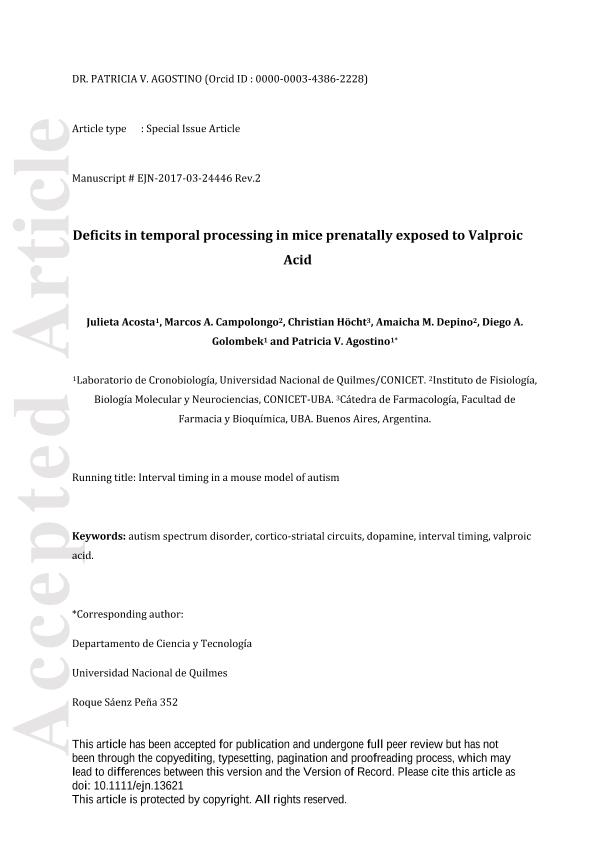Artículo
Deficits in temporal processing in mice prenatally exposed to Valproic Acid
Acosta, Julieta ; Campolongo, Marcos Andrés
; Campolongo, Marcos Andrés ; Höcht, Christian; Depino, Amaicha Mara
; Höcht, Christian; Depino, Amaicha Mara ; Golombek, Diego Andrés
; Golombek, Diego Andrés ; Agostino, Patricia
; Agostino, Patricia
 ; Campolongo, Marcos Andrés
; Campolongo, Marcos Andrés ; Höcht, Christian; Depino, Amaicha Mara
; Höcht, Christian; Depino, Amaicha Mara ; Golombek, Diego Andrés
; Golombek, Diego Andrés ; Agostino, Patricia
; Agostino, Patricia
Fecha de publicación:
03/2018
Editorial:
Wiley Blackwell Publishing, Inc
Revista:
European Journal Of Neuroscience
ISSN:
0953-816X
Idioma:
Inglés
Tipo de recurso:
Artículo publicado
Clasificación temática:
Resumen
Temporal processing in the seconds-to-minutes range, known as interval timing, is a crucial cognitive function that requires activation of cortico-striatal circuits via dopaminergic–glutamatergic pathways. In humans, both children and adults with autism spectrum disorders (ASD) present alterations in their estimation of time intervals. At present, there are no records of interval timing studies in animal models of ASD. Hence, the objective of the present work was to evaluate interval timing in a mouse model of prenatal exposure to valproic acid (VPA) – a treatment used to induce human-like autistic features in rodent models. Animals were assessed for their ability to acquire timing responses in 15-s and 45-s peak-interval (PI) procedures. Our results indicate that both female and male mice prenatally exposed to VPA present decreased timing accuracy and precision compared to control groups, as well as deviations from the scalar property. Moreover, the observed timing deficits in male VPA mice were reversed after early social enrichment. Furthermore, catecholamine determination by HPLC-ED indicated significant differences in striatal dopaminergic, but not serotonergic, content in female and male VPA mice, consistent with previously identified alterations in dopamine metabolism in ASD. These deficits in temporal processing in a mouse model of autism complement previous results in humans, and provide a useful tool for further behavioral and pharmacological studies.
Archivos asociados
Licencia
Identificadores
Colecciones
Articulos(IFIBYNE)
Articulos de INST.DE FISIOL., BIOL.MOLECULAR Y NEUROCIENCIAS
Articulos de INST.DE FISIOL., BIOL.MOLECULAR Y NEUROCIENCIAS
Citación
Acosta, Julieta; Campolongo, Marcos Andrés; Höcht, Christian; Depino, Amaicha Mara; Golombek, Diego Andrés; et al.; Deficits in temporal processing in mice prenatally exposed to Valproic Acid; Wiley Blackwell Publishing, Inc; European Journal Of Neuroscience; 47; 6; 3-2018; 619-630
Compartir
Altmétricas



